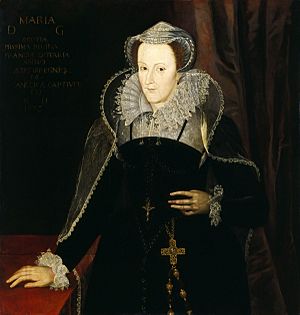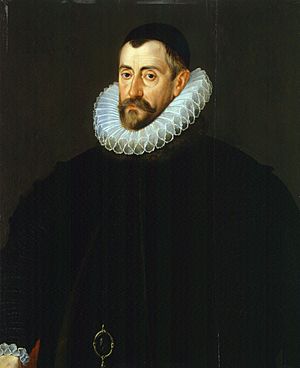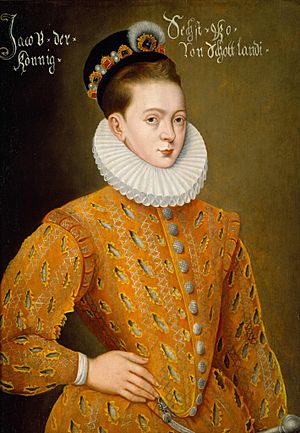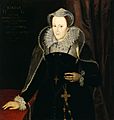Michel de Castelnau facts for kids
Michel de Castelnau, Sieur de la Mauvissière (around 1520–1592) was a French soldier and a diplomat. He served as an ambassador to Queen Elizabeth I of England. He also wrote a book about his experiences from 1559 to 1570.
Contents
Life Story
Michel de Castelnau was born in a place called La Mauvissière, in France, around 1520. He was one of nine children. His grandfather had been a Master of the Horse for King Louis XII of France.
Michel was very smart and had a great memory. He received a good education, which included traveling in Italy and spending time in Rome. After that, he visited Malta and then joined the army. He first experienced war during France's campaigns in Italy. His skills and bravery impressed Charles, Cardinal of Lorraine, who became his friend and protector.
In 1557, he was given a command in the navy. He later rejoined the French army. King Henry II trusted him with important tasks that needed careful handling. He was sent to Scotland to deliver messages to Mary of Guise, who was the mother of Mary, Queen of Scots. Mary, Queen of Scots, was going to marry the French prince, Francis II.
In 1559, he traveled from Scotland to England. There, he talked with Queen Elizabeth about England's claims on Calais. They reached an agreement at a meeting called the congress of Le Cateau-Cambrésis. After this, he was sent as an ambassador to German princes. His goal was to convince them to stop supporting the Protestants. He also went on missions to the Netherlands, Savoy, and Rome. In Rome, he tried to understand the views of Pope Paul IV about France. When Paul died, Castelnau helped in the election of the new Pope, Pius IV.
Back in France, he rejoined the navy. He was lucky enough to discover the early signs of a plot called the Conspiracy of Amboise. He immediately told the government about it.
After King Francis II died in December 1560, Castelnau went with Mary, Queen of Scots, to Scotland. He stayed with her for a year. During this time, he traveled to England many times. He tried to help Mary and Queen Elizabeth become friends again. However, Mary did not listen to his wise advice.
In 1562, he returned to France because of a civil war. He fought against the Protestants in Brittany. He was captured but soon exchanged. Even though his country was full of strong feelings, Castelnau, who was a strong Roman Catholic, stayed calm and fair. His advice was very helpful to the government. He fought in the siege of Rouen and showed bravery at the battle of Dreux. He also helped take back Havre from the English in 1563.
Diplomatic Missions in the 1560s
For the next ten years, Castelnau worked on many important missions. First, he went to Queen Elizabeth to discuss peace. In March 1564, he visited Scotland. He encouraged Mary, Queen of Scots, to marry a French Duke. After Mary married Lord Darnley in July 1565, Castelnau helped with diplomatic responses to her problems. He visited her at Holyroodhouse and later at Edinburgh Castle in April 1566, when she was pregnant.
French Wars of Religion
Castelnau was sent to the Duke of Alba, who was the new governor of the Netherlands. During this time, Castelnau found out about a plan by the Prince of Condé and Admiral Coligny. They planned to capture the royal family at Monceaux in 1567. After the battle of St. Denis, he was sent to Germany again. He asked for help against the Protestants. When he returned, he was rewarded with the job of governor of Saint-Dizier. He also received a company of soldiers. He led his company in the battles of Jarnac and Moncontour.
Ambassador in London
In 1572, King Charles IX sent Castelnau to England. His job was to calm the anger caused by the St. Bartholomew's Day Massacre. The same year, he was sent to Germany and Switzerland. In September 1575, King Henry III made him ambassador to Queen Elizabeth again. He stayed at her court for ten years. During this time, he tried to arrange a marriage between Queen Elizabeth and the Duke of Alençon. This was to make the alliance between England and France stronger. But Elizabeth made many promises and then broke them. Eventually, Castelnau refused to accept her promises or tell his government about them.
The Italian thinker Giordano Bruno lived with Castelnau's family in London for two years. Bruno wrote three books about the universe and dedicated them to Castelnau. The Italian writer John Florio also worked for Castelnau from 1583 to 1585. Florio also taught Castelnau's daughter, Katherine Maria. Castelnau's wife, Marie, had difficult pregnancies. She often traveled between England and France to see doctors, which cost a lot of money.
Mary, Queen of Scots, and Secret Letters

In London, Castelnau de Mauvissière lived near Fleet Street. Mary, Queen of Scots, who was held captive, sent him letters from Sheffield Manor and Castle. He then gave her letters to Queen Elizabeth I. Castelnau's wife, Marie, sent clothes to Mary. She also helped Mary find women to join her household. Mary called Marie her "ma commère", meaning her namesake. Mary thought of Castelnau's daughter as her godchild and her "mignonne" (darling). She sent her a jewel that King Henry II of France had given her.
Mary's Requests
Castelnau showed some of Mary's letters to William Fowler, who then told Francis Walsingham. Mary had written that she was not Elizabeth's prisoner. Instead, she said she was a captive of the Lord Treasurer, William Cecil. Mary wrote secret letters using a cipher (a code) to Castelnau. In 1581, she complained about her bad treatment. She asked for French money, soldiers, and cannons. She wanted these to be sent according to the old alliance between France and Scotland, called the Auld Alliance. In 1582, she hoped Castelnau's talks would lead to her freedom. She also wanted an "association" with her son, meaning they would rule together. For the short term, she wanted Castelnau to get permission for her to visit Buxton for her health. Mary's doctor, Dominique Bourgoing, kept Castelnau updated on Mary's health problems. Castelnau also asked Queen Elizabeth I to allow clothes, letters, and food from France to be delivered to Mary.
Castelnau's letters kept Mary informed about what was happening in France. Castelnau helped get a passport for Jean de Champhuon, Mary's French chamberlain. This allowed him to travel and help Mary with her affairs.

Intercepted Letters
Some of Castelnau's letters to Scotland were stopped and read by English diplomats. In September 1582, Queen Elizabeth I was told that Castelnau secretly sent letters to Mary and her supporters in Scotland. Francis Walsingham asked the ambassador in France to tell King Henry III of France and the Queen Mother, Catherine de' Medici, about this. He suggested that their representative in England should be more careful with Mary's letters. Elizabeth did not want to cause more trouble in Scotland after the recent Raid of Ruthven.

Mary sent several letters to Castelnau, some in code. She hoped for a strong French response against the Ruthven government. In April 1583, William Cecil made a list of Castelnau's past letters and talks with a Scottish plotter named Archibald Douglas. A spy offered to pay Castelnau's secretary to keep Francis Walsingham informed about the coded letters. The spy also wanted the key to the special code used in Castelnau's letters with Mary, Queen of Scots. In September 1584, Castelnau sent copies of his letters with Mary to Walsingham. This was to help with upcoming talks.
Code Work in Mary's Household
Mary asked Castelnau to be very careful with her secret letters. She also asked him to pay the messengers well. She told him to pretend the money was for gold and silver embroidery thread. She sent cipher keys (code alphabets) to his secretary, Claude de Courcelles. In 2023, about 57 coded letters from Mary, Queen of Scots, to Castelnau were found in a French library. They were then decoded. Mary's secretaries likely put the letters into code.
Mary's secretaries were taken to the Tower of London in September 1586. This happened during the discovery of the Babington Plot. One of them, Jérôme Pasquier, was questioned about plots and the coding process. He admitted to coding and decoding letters for Mary. He also said he had decoded many letters written by Monsieur de Mauvissière. After Mary's funeral in August 1587, all three men were released and allowed to leave England.
The Throckmorton Plot
The Throckmorton Plot was discovered in late 1583. Some of Mary's secret letters to Castelnau were carried by Francis Throckmorton to Claude de Courcelles. In the coded letters, Throckmorton was given the codename "Monsieur de la Tour." Another of Castelnau's secretaries, Chérelles, who Mary trusted, passed copies of Castelnau's letters to Walsingham.
This wider plot, discovered by Walsingham, involved Throckmorton. The goal was supposedly to help Spain invade England, kill Queen Elizabeth, and put Mary on the English throne.
When this plot was revealed in November 1583, Castelnau's position as a diplomat became weaker. Later, in September 1586, Mary's servant Jérôme Pasquier confessed. He said he wrote a coded letter for Mary to Castelnau. In it, Mary asked Castelnau to try and get a pardon for Francis Throckmorton in a prisoner exchange. However, Throckmorton was executed.
Mary's "Association" Plan
In August 1584, Castelnau was involved in plans for Mary's secretary, Claude Nau, to come to London. Nau was to meet Queen Elizabeth I as a diplomat. He would discuss Mary's plan for her "association" with her son, James VI. Castelnau offered to work fully with Francis Walsingham. In September, he sent Walsingham his recent letters with Mary. He told Walsingham about a plan to send another diplomat to Scotland. Castelnau did not want to work with Nau on these talks, as Mary wished. This was because his involvement with Mary had made Elizabeth suspicious of him. Walsingham understood that Castelnau was now more aligned with English policy. He asked an English diplomat to try and make sure Castelnau was not replaced.
Last Months in London
In February 1585, Castelnau wrote to Mary's son, James VI. He reported that Mary was hopeful and happy in her new home at Tutbury Castle. She hoped to be freed and join James in an "association," meaning they would rule together. Castelnau thought he would be sent to Scotland to help bring peace between Scotland, England, and France. This mission never happened.
His secretary, Courcelles, became suspected of double-dealing in March 1585. He was accused of carrying letters to a man who planned to kill someone. He continued to carry letters for Mary after Castelnau left England. Queen Elizabeth heard that Castelnau had sent him away for bad behavior.
When Castelnau returned to France in September 1585, he wrote to Francis Walsingham. He said he was sending John Florio to the court to thank Queen Elizabeth I for the silver gifts he had received. Sadly, the boat carrying Castelnau's luggage and treasures back home sank because of pirates. The new French ambassador in London was Guillaume de l'Aubespine de Châteauneuf. He received many coded letters to Mary that had not been sent yet.
Return to France
When Castelnau returned to France, he found that his castle, La Mauvissière, had been destroyed in the civil war. He refused to support a group called the League. Because of this, the Duke of Guise took away his job as governor of Saint-Dizier. He became very poor. But when Henry IV became king, he knew Castelnau was valuable. Even though Castelnau was Catholic, the king trusted him. So, King Henry IV gave him a command in the army and trusted him with many secret missions.
Death and What He Left Behind
Castelnau died in Joinville in 1592. His book, Mémoires (memoirs), is a very important source of information for the years 1559 to 1570. He wrote it for his son during his last time as ambassador in England. The book is clear, truthful, and fair. It was first printed in 1621. Castelnau also translated a Latin book into French. This book was about the customs of the ancient Gauls. Many of his letters are kept in the British Museum.
Castelnau married Marie, who was the daughter of another diplomat. She died in December 1586 in Paris. Their grandson, Jacques de Castelnau (1620–1658), became a famous soldier. He fought well in wars against Austria and Spain. He later became a Marshal of France.
Images for kids






